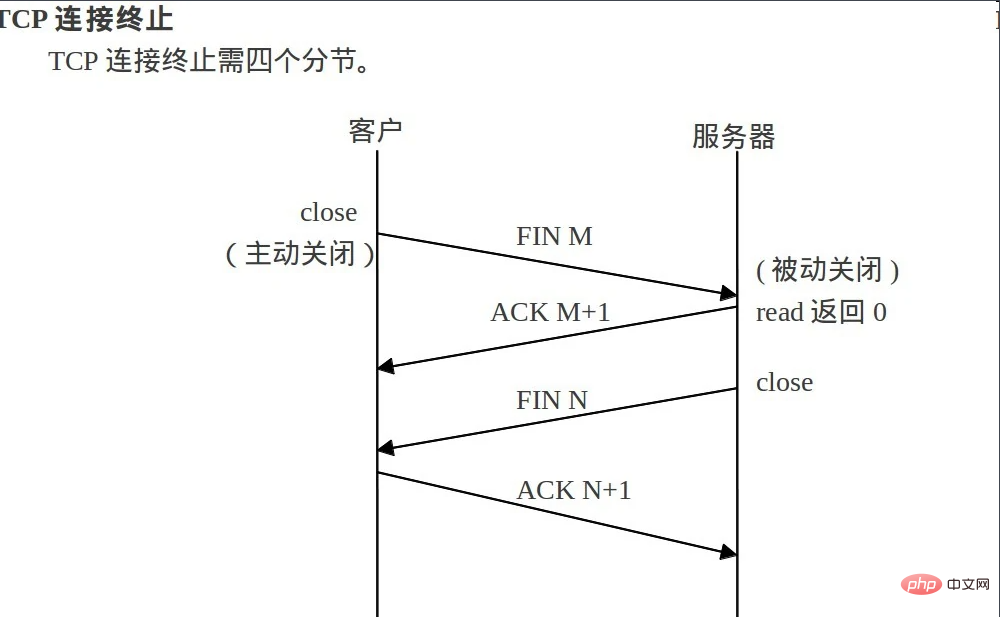Which layer of protocol does tcp belong to?
tcp is the "transport layer" protocol. TCP refers to "Transmission Control Protocol", which is a connection-oriented, reliable, byte stream-based transport layer communication protocol. TCP complements the Internet Protocol. It defines the IP address used to identify systems on the Internet. It mainly Ensure end-to-end data transfer between different nodes.

The operating system for this tutorial: Windows 10 system, DELL G3 computer.
TCP protocol (Transmission Control Protocol) is a connection-oriented and reliable protocol. It is designed for reliable data transmission between hosts in a computer network. The TCP protocol belongs to the transport layer in the network layer protocol. It is in the fourth layer of the OSI model, the transport layer, and is a point-to-point protocol.

tcp refers to "Transmission Control Protocol", which is a connection-oriented, reliable, byte stream-based transport layer communication protocol. TCP complements the Internet Protocol , which defines the IP address used to identify systems on the Internet, mainly ensuring end-to-end data transmission between different nodes.
The TCP/IP hierarchical model is divided into the following four layers:
1. Application layer, corresponding to the high level of the OSI reference model, provides users with various services required;
2. Transport layer, which provides end-to-end communication functions for application layer entities, ensuring the sequential transmission of data packets and data integrity;
3. Network layer, responsible for communication between adjacent nodes Communication;
4. Network interface layer, responsible for monitoring the exchange of data between the host and the network.
As a reliable protocol, the TCP protocol provides many important functions. First, it provides reliability of data transmission. This means that the TCP protocol can guarantee the correctness and integrity of data. In order to achieve reliable transmission, the TCP protocol introduces technologies such as sequence numbers, confirmation responses, and retransmission mechanisms to ensure the reliability of data.
Secondly, the TCP protocol provides congestion control. Congestion control refers to the mechanism in the network to prevent excessive data injection from causing network congestion. By monitoring network conditions, the TCP protocol can dynamically adjust the rate at which data is sent to avoid network congestion, thereby improving network stability and reliability.
In addition, the TCP protocol also provides flow control. Flow control refers to a mechanism that adjusts the data transmission rate between the sender and the receiver to prevent the sender from sending too much data to the receiver that the receiver cannot process. Through flow control, the TCP protocol can ensure that the sender does not exceed the processing capabilities of the receiver, thereby ensuring reliable transmission of data.
Although the TCP protocol provides important functions such as reliable transmission, congestion control, and flow control, it also has some limitations. For example, the reliability and complexity of the TCP protocol can lead to higher transmission delays. In addition, in scenarios of real-time communication and large-scale concurrent connections, the performance of the TCP protocol may be limited.
However, despite these limitations, the TCP protocol is still widely used in various Internet applications. For example, WWW (World Wide Web) is based on the TCP protocol. HTTP (Hypertext Transfer Protocol), as the protocol of WWW, uses TCP protocol at the bottom layer to achieve reliable transmission of data. In addition, the TCP protocol is also widely used in email, File Transfer Protocol (FTP), Remote Login Protocol (Telnet), etc.
Summary:
As a connection-oriented and reliable transmission protocol, the TCP protocol is a protocol in the transport layer. It ensures the stability and reliability of network communications by providing functions such as reliable transmission, congestion control, and flow control. Although the TCP protocol has some limitations, it is still widely used in various Internet applications and plays an important role
The above is the detailed content of Which layer of protocol does tcp belong to?. For more information, please follow other related articles on the PHP Chinese website!

Hot AI Tools

Undresser.AI Undress
AI-powered app for creating realistic nude photos

AI Clothes Remover
Online AI tool for removing clothes from photos.

Undress AI Tool
Undress images for free

Clothoff.io
AI clothes remover

Video Face Swap
Swap faces in any video effortlessly with our completely free AI face swap tool!

Hot Article

Hot Tools

Notepad++7.3.1
Easy-to-use and free code editor

SublimeText3 Chinese version
Chinese version, very easy to use

Zend Studio 13.0.1
Powerful PHP integrated development environment

Dreamweaver CS6
Visual web development tools

SublimeText3 Mac version
God-level code editing software (SublimeText3)

Hot Topics
 1393
1393
 52
52
 1205
1205
 24
24
 How to change tcp protocol in win11? Details of how to change tcp protocol in win11 system
Feb 01, 2024 pm 05:30 PM
How to change tcp protocol in win11? Details of how to change tcp protocol in win11 system
Feb 01, 2024 pm 05:30 PM
One of the transport protocols in Windows systems is the TCP protocol, which is required when running and using certain functions. Recently, some Win11 users have encountered problems with the TCP protocol and need to modify it. However, many people don’t know how to make successful modifications. In order to solve this problem, this Win11 tutorial will provide you with detailed setting methods. Please visit this site for the complete steps if you need them. How to change the TCP protocol in win11: 1. First, right-click the network icon in the lower right corner to open the network and internet settings. 3. Then open more network adapter options under relevant settings. 5. After opening, you can find the tcp protocol. Double-click it to open it. 7. You can also click Advanced to repair
 TCP protocol and asynchronous IO processing technology in Go language
Jun 02, 2023 am 09:10 AM
TCP protocol and asynchronous IO processing technology in Go language
Jun 02, 2023 am 09:10 AM
With the continuous development of Internet technology, TCP protocol and asynchronous IO processing technology have become increasingly important. As a modern programming language, Go language naturally supports TCP protocol and asynchronous IO processing technology, which makes Go language extremely convenient and efficient in developing network applications. This article will discuss the advantages of Go language in network application development from two aspects: TCP protocol and asynchronous IO processing technology. 1. TCP protocol The TCP protocol is a reliable, connection-oriented network transmission protocol. It can ensure the reliability of network transmission,
 How to change TCP protocol settings in Windows 11 system
Apr 02, 2024 pm 01:43 PM
How to change TCP protocol settings in Windows 11 system
Apr 02, 2024 pm 01:43 PM
In the Windows 11 operating system, the TCP protocol, as a key part of the underlying communication architecture, plays an indispensable role in the stable operation of many functions in the system. When users intend to make personalized adjustments to the TCP protocol according to their own needs, they may face operational confusion. To this end, here are the detailed steps on how to change TCP protocol settings in Windows 11 system. Let’s take a look. Change method 1. Right-click the network icon in the taskbar in the lower right corner, and then select "Network and Internet Settings" in the option list. 2. After entering the new interface, click the "Advanced Network Settings" option on the right. 3. Then click "More Network Adapter Options" in "Related Settings". 4. of
 Which layer of protocol does tcp belong to?
Jul 05, 2023 am 10:52 AM
Which layer of protocol does tcp belong to?
Jul 05, 2023 am 10:52 AM
tcp is a "transport layer" protocol. TCP refers to "Transmission Control Protocol", which is a connection-oriented, reliable, byte stream-based transport layer communication protocol. TCP complements the Internet Protocol. It defines the IP address used to identify systems on the Internet. It mainly Ensure end-to-end data transfer between different nodes.
 Workerman development: How to implement file transfer based on TCP protocol
Nov 07, 2023 am 09:14 AM
Workerman development: How to implement file transfer based on TCP protocol
Nov 07, 2023 am 09:14 AM
Workerman development: How to implement file transfer based on TCP protocol, specific code examples are required. Introduction: In today's Internet era, file transfer has become an indispensable part of daily work and life. File transfer based on TCP protocol is a method with high transmission efficiency and strong reliability. In this article, we will introduce how to use the Workerman framework to develop a file transfer service based on the TCP protocol, and provide specific code examples. 1. What is Workerman? Workerman
 Workerman development: How to implement instant messaging based on TCP protocol
Nov 07, 2023 am 10:34 AM
Workerman development: How to implement instant messaging based on TCP protocol
Nov 07, 2023 am 10:34 AM
Workerman development: How to implement instant messaging based on TCP protocol Introduction: With the development of the Internet era, instant messaging plays an important role in our daily lives. Instant messaging based on the TCP protocol has become a common solution. This article will introduce how to use the Workerman framework to implement instant messaging based on the TCP protocol by writing specific code examples. 1. Introduction to Workerman Workerman is a high-performance PHPSocket service framework
 How to use TCPF protocol for network communication in Go language
Mar 28, 2024 am 08:06 AM
How to use TCPF protocol for network communication in Go language
Mar 28, 2024 am 08:06 AM
How to use TCP protocol for network communication in Go language. In Go language, we can use the method provided by the net package to implement TCP protocol for network communication. By establishing a TCP connection, we can achieve data transmission between the client and the server. The following will introduce in detail how to use the TCP protocol for network communication in the Go language, including client and server-side implementations, as well as specific code examples. 1.TCP client in Go language, we can build it through the Dial function provided by the net package
 Workerman development: How to implement a remote file management system based on TCP protocol
Nov 07, 2023 am 08:46 AM
Workerman development: How to implement a remote file management system based on TCP protocol
Nov 07, 2023 am 08:46 AM
Workerman development: How to implement a remote file management system based on TCP protocol Introduction: With the rise of cloud computing and remote work, remote file management systems have become the needs of more and more enterprises and individuals. In this article, we will introduce how to use the Workerman framework to implement a remote file management system based on the TCP protocol, and provide specific code examples. 1. Preparation Before starting to write code, we need to prepare some necessary tools and environment. First, make sure you have a PHP environment installed,



